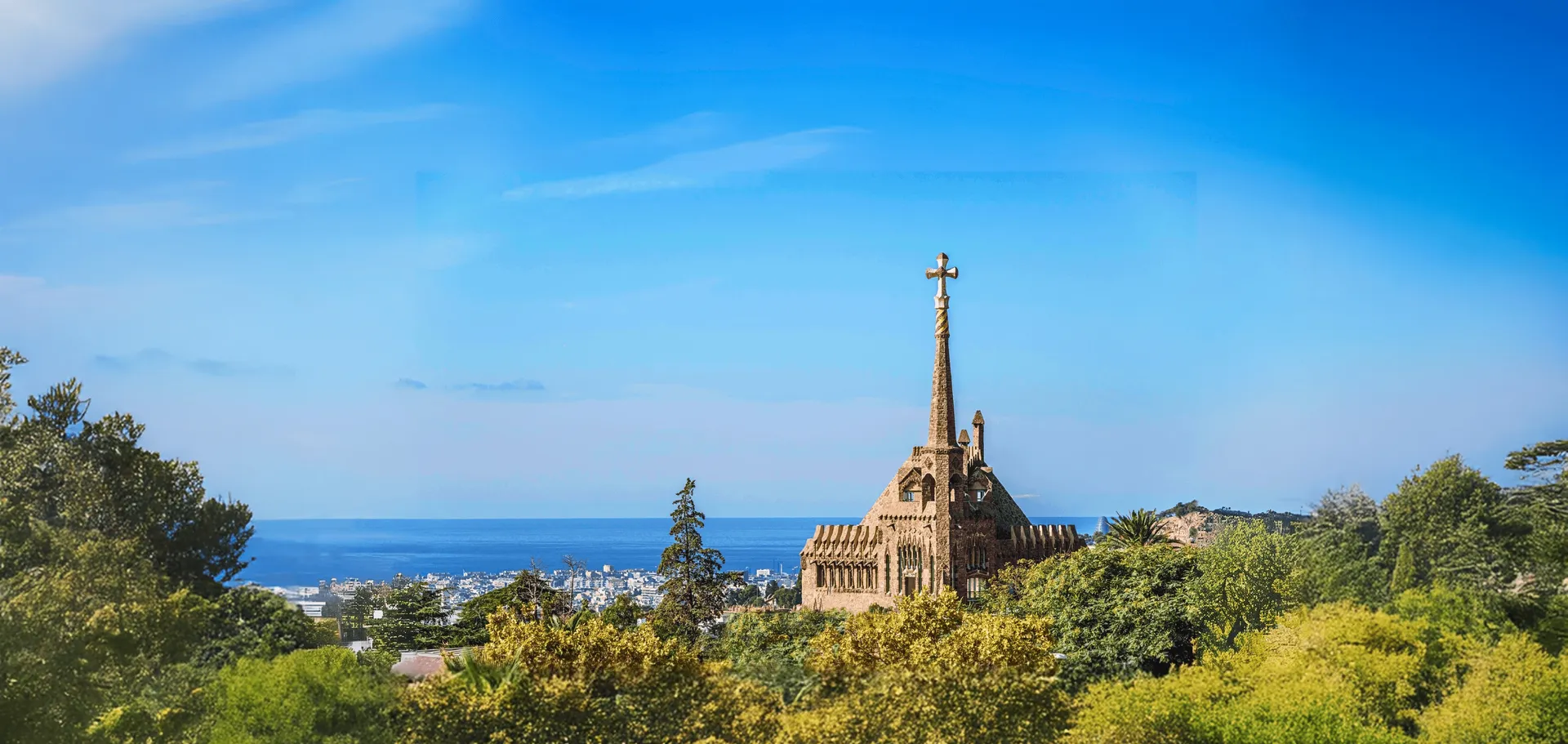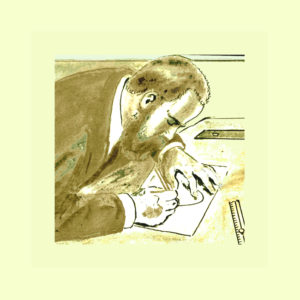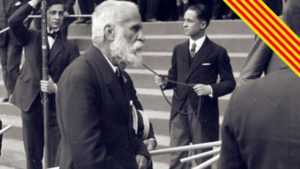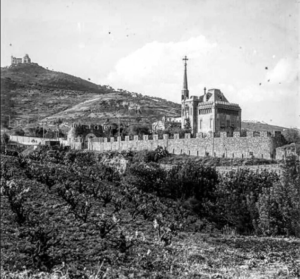September 28, 2025
By Ferran Garcés
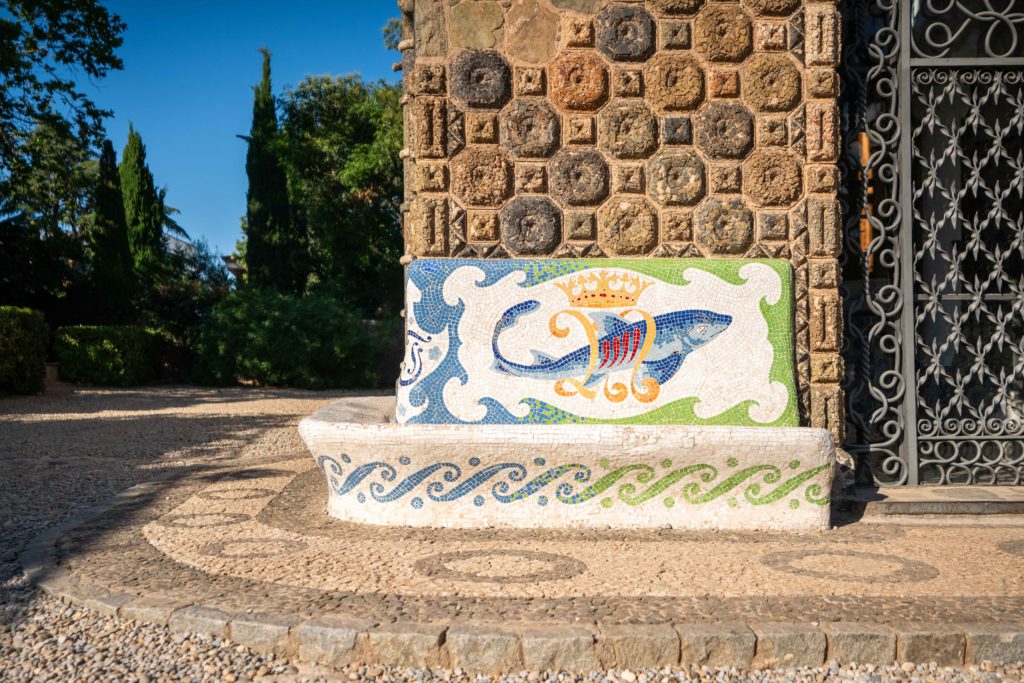
Does coincidence exist?
This question has been widely and profoundly addressed by philosophy and religion, but that is not the purpose of our article — though the example lends itself to reflection. Today, we only want to mention a few events related to the history of Bellesguard that took place in September, the month we are in now. Coincidence, chance, fate, destiny… whatever it may be, all of this happened at Bellesguard in this month, or around it — that is, at the beginning of autumn.
September 3 and 4, 1285
The main decorative motif of the Torre Bellesguard façade is a mosaic located at both sides of the main door, which recreates a well-known phrase by Roger de Llúria, admiral of the fleet of the House of Barcelona:
“From now on, there will be no fish that dares to raise its tail unless it carries tied to it the flag with the four stripes of our lord, the King of Aragon.”
This phrase was pronounced after his triumph in the Naval Battle of Les Formigues, on September 3 and 4, 1285, during the conflict between the Crown of Aragon, under Peter the Great, and the Kingdom of France, under Philip III the Bold. It was an era of splendor to which Gaudí, and his assistant Domènech Sugranyes, paid homage when building the house. For this reason, the tower rises like a medieval castle and is surrounded by nostalgic symbols, such as the mosaic of Roger de Llúria.
September 1408
During September 1408, Martin I the Humane, a member of the same crown defended by Roger de Llúria, intensified his search for a residence at the foot of Collserola. The area of the current Sarrià and Sant Gervasi neighborhoods offered a peaceful setting, yet close to the city of Barcelona. Several great lords of the time had made it a leisure area and had invited the monarch to their towers on various occasions. Around September 27, Martin I spent a few days at Mas de Vallblanc and, enchanted by the place, immediately began arrangements to acquire it. The formal purchase was made on October 13 of the same year.
The notary for the transaction was Bernat Metge, a well-known Catalan writer and royal secretary. By his suggestion, according to some, or by the king himself, according to others, Martin I changed the name of the estate, calling it Bellesguard, meaning “beautiful view.” As swift as the purchase was the renovation to adapt it to the royal status of its new owner.
September 17, 1409
This date marks the most significant event in the history of Bellesguard: the marriage between King Martin and Margaret of Prades. The ceremony was officiated by Benedict XIII, better known as Pope Luna. On September 23, Vincent Ferrer, the future saint, delivered one of his legendary sermons during a Mass celebrated by his brother Boniface Ferrer.
September 16, 1410 & September 5, 1414
The “fish” of Roger de Llúria and the reign of Martin the Humane are considered an era of splendor for Catalonia. However, after the king’s death without a legitimate heir or appointed successor, a period of decline ensued, traditionally associated with the beginning of the Trastámara dynasty. Torre Bellesguard is filled with symbols that allude to the contrast between prosperity and decadence.
King Martin I died on May 31, 1410. At the end of June, Ferdinand of Trastámara, the king’s maternal grandson, received the news of his death while leading the conquest of Antequera. He finally entered the strategic city on September 16 and, by the end of the month, formally presented his candidacy for succession. It was not easy to validate his claim. Two years passed before he was chosen in the Compromise of Caspe. Even then, he had to wait longer due to the revolt of James II of Urgell, the only contender who refused to accept the result. The long-awaited coronation of Ferdinand of Antequera took place on September 5, 1414.
September 25, 1412
Meanwhile, in Bellesguard, various women disputed the right to reside in King Martin’s palace. It appears that Margaret of Prades, the young widowed queen, remained at Bellesguard only briefly. We know from documents that she was still living there on September 25, 1412, the year of the Compromise of Caspe. A few days later, on October 4, she stopped mentioning Bellesguard in her letters and referred only to Barcelona, suggesting that she had likely moved to the Palau Menor, another building from her inheritance.
September 30, 1424
After several quick ownership changes, on September 30, 1424, Leonor de Cervelló, a lady of the court, acquired the Palace of Bellesguard, where she lived with Queen Violant of Bar, widow of King John I, brother of Martin the Humane. The next owner was Cecilia of Urgell, sister of James II of Urgell and the only member of her family to survive the reprisals of Ferdinand of Antequera. However, the date of her purchase was February 11, 1446, an exception to the “September rule.” With her, the last person who had witnessed the origins of Bellesguard disappeared.
September 1651
During the Reapers’ War, Barcelona was besieged from August 1651 to October 1652. Documents and engravings from the time confirm the strategic importance of military positions along Collserola. One of the fiercest confrontations occurred in September 1651, near Sarrià, close to Bellesguard. After the siege, the victors ordered the dismantling of all fortifications outside the city walls, including those at the foot of Collserola, to prevent their reuse in future conflicts. Bellesguard was likely partially destroyed at this time. Abandoned to its fate, the estate remained uninhabited until 1662, when it was acquired by Joan Ferrer Gualbes de Bonaventura i Copons, a member of the prominent Gualbes family.
September 11, 1714
This date marks the end of another siege of Barcelona during the War of Spanish Succession, with tragic consequences for Catalonia. One of the officers who fought to the end was Joan Gualbes i Copons, owner of Bellesguard, who died in December 1714 from his wounds.
Shortly before that fateful day, he had restored Bellesguard and revived part of its splendor, turning it into the headquarters of the Acadèmia dels Desconfiats, an association of enlightened nobles opposed to Philip V, the king who had ordered the siege. To avoid expropriation, he ceded the estate to the Basilica of Saints Justus and Pastor, and entrusted it with the Book of Bellesguard, an archive containing all documents from the time of King Martin. Nevertheless, time eventually left the palace in poor condition.
September 18, 1893
Joan Grau, Bishop of Astorga, friend of Gaudí and purchaser of the ruined Bellesguard estate, passed away. Earlier, he had entrusted the property’s deeds to Gaudí while the architect was in Astorga overseeing construction of the Episcopal Palace.
September 4, 1900
Official date of the commission to build Torre Bellesguard, made by Maria Sagués, widow of Joan Figueras, a friend of Gaudí who died before the project began.
September 11, 1924
Date of Gaudí’s arrest while he was on his way to a ceremony honoring those who fell during the 1714 siege of Barcelona. Curiously, he was arrested in front of the Basilica of Saints Justus and Pastor, where Joan Gualbes had entrusted both the estate and the history of the ancient palace. Gaudí consulted the Book of Bellesguard to document the site’s past and pay homage to King Martin I and the Catalonia of Roger de Llúria’s “fish.”
September 17, 2013
The Guilera Roche family, then owners of Torre Bellesguard, opened their home to the public for the first time. A long list of adaptations was undertaken to facilitate visits, and the Bellesguard Research Team was formed. Everything we know today is the result of studies by this interdisciplinary group. It’s worth noting that this work by Gaudí had never been studied before. The Book of Gualbes kept at the Basilica of Saints Justus and Pastor was the main guide.
September 25, 2018
The company Occident purchased Torre Bellesguard, becoming its current owner. Under its stewardship, Bellesguard continues to expand research, promote its long history, and improve the visitor experience. Soon, new activities will be announced to commemorate the centenary of Gaudí’s death in 2026.
We hope to continue walking together through many more Septembers!
Notes
(1) Galindo López, Esteban (2020), Analysis of the Historical Landscape in the Northern Area of the Barcelona Plain, 15th to 18th Centuries: Bellesguard, Doctoral Thesis, University of Barcelona, pp. 121-124.
(2) Vall i Comaposada, Josep M. (2014), Bellesguard. From the Residence of Martin the Humane to Gaudí’s Tower, Barcelona, Duxelm Editorial, pp. 45-47 and p. 60.
(3) Ibid, pp. 52-61.
(4) Ibid, p. 75.
(5) Ibid, pp. 77-79.

